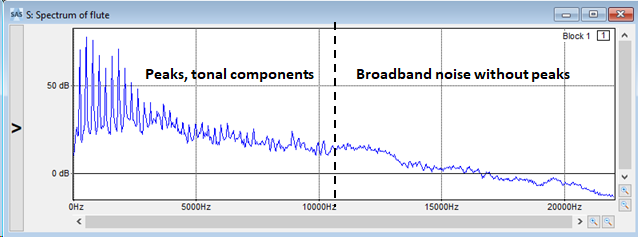Methods for Sound Creation
This section describes the methods used for sound creation from a spectrum.
Sound: Analysis and Specification provides three different methods for generating a sound signal from a single spectrum or from a series of spectra (also called "waterfall").
All the sound generation methods provided in the software require a "spectrum" as input. This spectrum is composed of a series of pairs of values (frequency, amplitude). Frequency is the frequency in Hz, amplitude is the signal RMS level at the corresponding frequency (the amount of RMS energy in the signal at that frequency, for example dB, or Pa²). Note that phase information is neither required nor supported as input. Depending on the generation method you choose, the phase information will be either randomly generated or specifically controlled by the algorithm.
Harmonic Model
The Harmonic model method generates a sound from a spectrum using sound synthesis from sinusoidal patterns.
Given a spectrum (level vs. frequency) as input, a sound sample is created. This sound sample contains harmonic components at the same exact frequencies specified in the input spectrum, each one having the same level as specified.
When you are generating a signal from a waterfall of multiple spectra, only this Harmonic method is available.
Noise Models
Inverse Fast Fourier Transform
The Inverse FFT method generates a sound from a spectrum using an inverse Fourier transform.
Given a spectrum (level vs. frequency) as input, a sound sample is created. This created sound sample has the same spectrum as the input spectrum.
Note: Inverse FFT synthesis is recommended for spectra that contain only broadband noise.Since phase information is not present in the input spectrum, the software uses a random phase in the signal.
-
Hybrid/Automatic
If a spectrum contains some noise and some pure tones, or if you are not sure of the composition of the spectrum, use the Hybrid method. Compared to the Inverse FFT method, the Hybrid method improves the sound quality of mixed spectra by processing the peaks that represent pure tones separately from the noise. Pure tones will sound better after Hybrid processing than if the spectrum were processed with IFFT alone.
First, the tonal components (peaks in the spectrum) are separated from the noisy components (broadband noise without peaks). You obtain two spectra: one with only the peaks and one with only the broadband components. The first spectrum is used to generate a sound with the Harmonic model method. The second one is used to generate a sound with the Inverse FFT method. Then, these two sounds are combined (mixed) to create the final sound signal where the peaks are sharpened, and the noise is softened. The tones in the final sound are more precise, and the sound quality is improved.
Note: Hybrid sound synthesis is recommended for spectra that contain both pure tones and broadband noise, or when you are not sure that there is no pure tone in your spectrum.
Broadband Noise Generation
This method is an extension of the Inverse FFT method to the case of noise whose spectrum is evolving in time. The broadband noise generation method takes a description of the evolution of the spectrum of the noise vs. a control parameter (for example the spectra of the noise of an HVAC system at different flow speeds) as input, and creates a sound sample whose spectrum evolves in time according to a given evolution of the control parameter (that is, you can give as input a profile of 20s during which the flow speed will evolve from minimum to maximum).
Note: the spectra describing the noise can be specified in narrow bands, octave bands or third octave bands.
Examples of Generated Sounds
Output sound generated from Flute input spectrum using the Hybrid/Automatic method:
Output sound generated from Flute input spectrum using the Inverse method:


